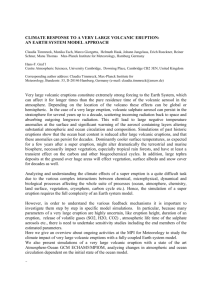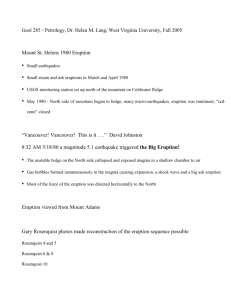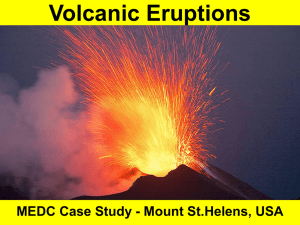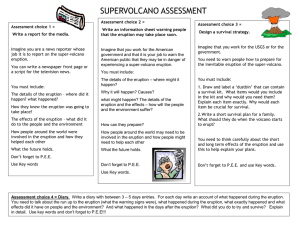Mount Pinatubo and Apu
advertisement
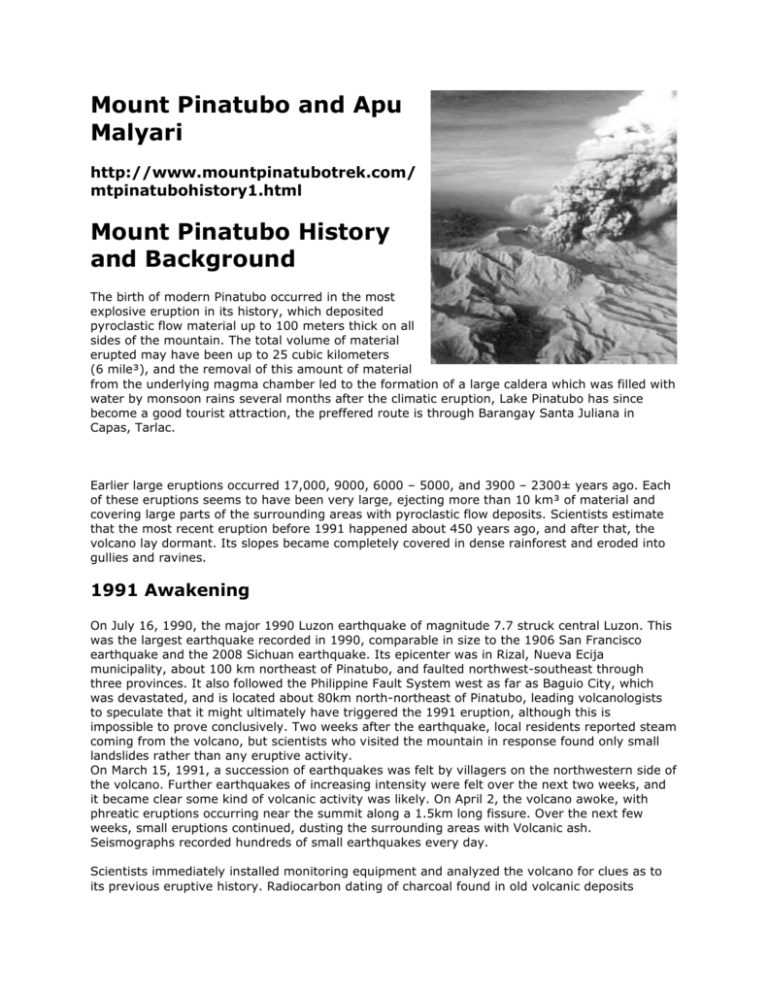
Mount Pinatubo and Apu Malyari http://www.mountpinatubotrek.com/ mtpinatubohistory1.html Mount Pinatubo History and Background The birth of modern Pinatubo occurred in the most explosive eruption in its history, which deposited pyroclastic flow material up to 100 meters thick on all sides of the mountain. The total volume of material erupted may have been up to 25 cubic kilometers (6 mile³), and the removal of this amount of material from the underlying magma chamber led to the formation of a large caldera which was filled with water by monsoon rains several months after the climatic eruption, Lake Pinatubo has since become a good tourist attraction, the preffered route is through Barangay Santa Juliana in Capas, Tarlac. Earlier large eruptions occurred 17,000, 9000, 6000 – 5000, and 3900 – 2300± years ago. Each of these eruptions seems to have been very large, ejecting more than 10 km³ of material and covering large parts of the surrounding areas with pyroclastic flow deposits. Scientists estimate that the most recent eruption before 1991 happened about 450 years ago, and after that, the volcano lay dormant. Its slopes became completely covered in dense rainforest and eroded into gullies and ravines. 1991 Awakening On July 16, 1990, the major 1990 Luzon earthquake of magnitude 7.7 struck central Luzon. This was the largest earthquake recorded in 1990, comparable in size to the 1906 San Francisco earthquake and the 2008 Sichuan earthquake. Its epicenter was in Rizal, Nueva Ecija municipality, about 100 km northeast of Pinatubo, and faulted northwest-southeast through three provinces. It also followed the Philippine Fault System west as far as Baguio City, which was devastated, and is located about 80km north-northeast of Pinatubo, leading volcanologists to speculate that it might ultimately have triggered the 1991 eruption, although this is impossible to prove conclusively. Two weeks after the earthquake, local residents reported steam coming from the volcano, but scientists who visited the mountain in response found only small landslides rather than any eruptive activity. On March 15, 1991, a succession of earthquakes was felt by villagers on the northwestern side of the volcano. Further earthquakes of increasing intensity were felt over the next two weeks, and it became clear some kind of volcanic activity was likely. On April 2, the volcano awoke, with phreatic eruptions occurring near the summit along a 1.5km long fissure. Over the next few weeks, small eruptions continued, dusting the surrounding areas with Volcanic ash. Seismographs recorded hundreds of small earthquakes every day. Scientists immediately installed monitoring equipment and analyzed the volcano for clues as to its previous eruptive history. Radiocarbon dating of charcoal found in old volcanic deposits revealed three major explosive eruptions in recent millennia, about 5500, 3500 and 500 years ago. Geological mapping showed that much of the surrounding plains were formed by lahar deposits from previous eruptions. Volcanic activity increased throughout May. Measurements of sulfur dioxide emissions showed a rapid increase from 500 tons per day by May 13 to 5,000 tons/day by May 28. This implied that there was a rising column of fresh magma beneath the volcano. After May 28, the amount of SO2 being emitted decreased substantially, raising fears that the degassing of the magma had been blocked somehow, leading to a pressure build-up in the magma chamber and a high likelihood of explosive eruptions. The first magmatic eruptions occurred on June 3, and the first large explosion on June 7 generated an ash column 7km (4.5miles) high. The Philippine Institute of Volcanology and Seismology (PHIVOLCS) issued a warning indicating the possibility of a major eruption within two weeks. Evacuation Given all the signs that a very large eruption was imminent, PHIVOLCS – assisted by the U.S. Geological Survey – worked to convince local inhabitants of the severity of the threat. A false warning might have led to cynicism about any later warnings, but delaying a warning until an eruption began might lead to thousands of deaths, so the volcanologists were under some pressure to deliver a timely and accurate assessment of the volcanic risk. Three successive evacuation zones were defined, the innermost containing everything within 10 km of the volcano's summit, the second extending from 10 to 20 km from the summit, and the third extending from 20 to 40 km from the summit (Clark Air Base and Angeles City were in this zone). The 10 km and 10 to 20km zones had a total population of about 40,000, while some 331,000 people lived in the 20–40km zone. Five stages of volcanic alert were defined, from level 1 (low level seismic disturbances) up to level 5 (major eruption in progress). Daily alerts were issued stating the alert level and associated danger area, and the information was announced in major national and local newspapers, on radio and television stations, by nongovernmental organizations (NGOs), and directly to the endangered inhabitants. Many of the Aeta who lived on the slopes of the volcano left their villages of their own volition when the first explosions began in April, gathering in a village about 12 km from the summit. They moved to increasingly distant villages as the eruptions escalated, some Aeta moving up to nine times in the two months preceding the cataclysmic eruption .The first formal evacuations were ordered from the 10 km zone on April 7. Evacuation of the 10–20 km zone was ordered when a level 4 alert was issued on June 7. A level 5 alert triggered evacuation of the 20–40 km zone on June 13, and in all some 60,000 people had left the area within 30 km of the volcano before June 15. Most people temporarily relocated to Manila and Quezon City, with some 30,000 using the Amoranto Velodrome in Quezon City as an evacuee camp. Eruptions' climactic buildup In early June, tiltmeter measurements had shown that the volcano was inflating, evidently due to growing amounts of magma filling the reservoir beneath the summit. At the same time, seismic activity, previously concentrated at a depth of a few kilometers below a point about 5 km northwest of the summit, shifted to shallow depths just below the summit. On June 7, the first magmatic eruptions took place with the formation of a lava dome at the summit of the volcano. The dome grew substantially over the next five days, reaching a maximum diameter of about 200 m and a height of 40 m. A small explosion at 03:41 on June 12 marked the beginning of a new, more violent phase of the eruption. A few hours later, large explosions lasting about half an hour generated an eruption column which quickly reached heights of over 19 km, and which generated pyroclastic flows extending up to 4 km from the summit in some river valleys. Fourteen hours later, a 15-minute eruption hurled ash to heights of 24 km. Friction in the up rushing ash column generated abundant lightning. A third large eruption began at 08:41 on June 13, after an intense swarm of small earthquakes over the previous two hours. It lasted about five minutes, and the eruption column once again reached 24 km. After three hours of quiet, seismic activity began, growing more and more intense over the next 24 hours, until a three-minute eruption generated a 21 km-high eruption column at 13:09 on June 14. Tephra fall from these four large eruptions was extensive to the southwest of the volcano. Two hours after the last of these four explosions, a series of eruptions began which lasted for the next 24 hours, and which saw the production of much larger pyroclastic flows and surges which traveled several kilometers down river valleys on the flanks of the volcano. The climactic eruption All the seismographs at Clark Air Base had been rendered inoperative by 14:30 on June 15, mostly by pyroclastic density currents. Intense atmospheric pressure variation was also recorded. On the same day, Typhoon Yunya struck the island, passing about 75 km (50 miles) north of the volcano. The typhoon rains made direct visual observations of the eruption impossible, but measurements showed that ash was ejected to heights of 34km (21 miles) by the most violent phase of the eruption, which lasted about three hours. Pyroclastic flows poured from the summit, reaching as far as 16 km away from it. Typhoon rains mixed with the ash deposits caused massive lahars. The ash cloud from the volcano covered an area of some 125,000 km² (50,000 mi²), bringing total darkness to much of central Luzon. Almost all of the island received some ashfall, which formed a heavy, rain-saturated snow-like blanket. Tephra fell over most of the South China Sea and ashfall was recorded as far away as Vietnam, Cambodia and Malaysia. Twelve days after the first magmatic eruptions of June 3, on June 15, 1991, by about 22:30, and about nine hours after the onset of the most recent climactic phase, atmospheric pressure waves had decreased to the pre-eruption levels. No seismic records were available at this time, but volcanologists believe 22:30 marked the end of the climactic eruption. Vast quantities of minerals and metals were brought to the surface. Overall, introduced to the surface environment, was an estimated 800,000 tons of zinc,1000 tons of cadmium, 600,000 tons of copper, 300,000 tons of nickel, 100,000 tons of lead, 10,000 tons of arsenic, 550,000 tons of chromium,& 800 tons of mercury. Aftermath In all, the eruption ejected about ten cubic kilometers (2.5 mile) of material, making it the largest eruption since that of Novarupta in 1912 and some ten times larger than the 1980 eruption of Mount St. Helens. Ejected material such as tephra fallout and pyroclastic flow deposits are much less dense than magma, and the volume of ejected material was equivalent to about four cubic kilometres (1mile) of un-erupted material. The former summit of the volcano was replaced by a caldera 2.5km wide. The highest point on the caldera rim now stood 1,485m above sea level, some 260m lower than the pre-eruption summit. Over 800 people were killed by the eruption, mostly by roofs collapsing under the weight of accumulated wet ash, a hazard that was greatly exacerbated by the simultaneous arrival of Typhoon Yunya. The evacuation in the days preceding the eruption certainly saved tens of thousands of lives, and has been hailed as a great success for volcanology and eruption prediction. However, since the eruption, each rainy season has brought further lahars, which have caused the displacement of thousands of people. Hundreds have died from poor sanitation in relocation camps. Agriculture in the region also suffered badly from the effects of the eruption, with hundreds of square kilometres of formerly arable land being rendered infertile, destroying the livelihoods of thousands of farmers. The United States maintained two large military bases in the region; U.S. Naval Base Subic Bay was 75 km (50 mi.) to the southwest, while Clark Air Base was less than 25 km (16 mi.) to the east of the volcano's summit. The United States Air Force initiated a massive airlift effort to evacuate American service members and their families during and immediately following the eruption, named Operation Fiery Vigil. Most personnel were initially relocated to Guam, Okinawa, and Hawaii, although some returned to the continental United States. Clark Air Base was ultimately abandoned by the United States military, and Subic Bay reverted to Philippines control the next year following the breakdown of lease negotiations. Local economic and social effects The eruption of Pinatubo severely hampered the economic development of the surrounding areas. Extensive damage to buildings and infrastructure cost billions of pesos to repair, and further costs were incurred in constructing dikes and dams to control the post-eruption lahars. In total, 364 communities and 2.1 million people were affected by the eruption, with livelihoods and houses being damaged or destroyed. More than 8,000 houses were completely destroyed, and a further 73,000 were damaged. In addition to the severe damage sustained by these communities, roads and communications were damaged or destroyed by pyroclastic flows and lahars throughout the areas surrounding the volcanoes. The estimated cost of repairing the damage to infrastructure was 3.8 billion pesos. Many reforestation projects were destroyed in the eruption, with a total area of 150 square kilometres (37,000 acres) valued at 125 million pesos destroyed. Agriculture was heavily disrupted, with 800 square kilometres (200,000 acres) of rice-growing farmland destroyed, and almost 800,000 head of livestock and poultry killed. The cost to agriculture of eruption effects was estimated to be 1.5 billion pesos. Damage to healthcare facilities, and the spread of illnesses in relocation facilities, led to soaring death rates in the months following the eruption. Education for thousands of children was seriously disrupted by the destruction of schools in the eruption. The gross regional domestic product of the Pinatubo area accounted for about 10% of the total Philippine gross domestic product. The GRDP had been growing at 5% annually before the eruption, but fell by more than 3% from 1990 to 1991. Global environmental effects The powerful eruption of such an enormous volume of lava and ash injected significant quantities of aerosols and dust into the stratosphere. Sulfur dioxide oxidised in the atmosphere to produce a haze of sulfuric acid droplets, which gradually spread throughout the stratosphere over the year following the eruption. The injection of aerosols into the stratosphere is thought to have been the largest since the eruption of Krakatoa in 1883, with a total mass of SO2 of about 17 million tons being injected—the largest volume ever recorded by modern instruments (see chart and figure). This very large stratospheric injection resulted in a reduction in the normal amount of sunlight reaching the Earth's surface by roughly 10% (see figure). This led to a decrease in northern hemisphere average temperatures of 0.5–0.6 °C (0.9–1.1 °F), and a global fall of about 0.4 °C (0.7 °F).12 At the same time, the temperature in the stratosphere rose to several degrees higher than normal, due to absorption of radiation by the aerosols. The stratospheric cloud from the eruption persisted in the atmosphere for three years after the eruption. The eruption had a significant effect on ozone levels in the atmosphere, causing a large increase in the destruction rate of ozone. Ozone levels at mid-latitudes reached their lowest recorded levels, while in the southern hemisphere winter of 1992, the ozone hole over Antarctica reached its largest ever size until then, with the fastest recorded ozone depletion rates. The eruption of Mount Hudson in Chile in August 1991 also contributed to southern hemisphere ozone destruction, with measurements showing a sharp decrease in ozone levels at the tropopause when the aerosol clouds from Pinatubo and Hudson arrived. Another noticeable effect of the dust in the atmosphere was the appearance of lunar eclipses. Normally even at mid-eclipse, the moon is still visible although much dimmed, but in the year following the Pinatubo eruption, the moon was hardly visible at all during eclipses, due to much greater absorption of sunlight by dust in the atmosphere. The Mt. Pinatubo area since 1991 Following the climactic eruption of June 15, 1991, activity at the volcano continued at a much lower level, with continuous ash eruptions lasting until August 1991 and episodic eruptions continuing for another month. Activity then remained low until July 1992, when a new lava dome began to grow in the caldera. This dome appeared to be composed of fresh lava from the deep magma reservoir beneath the volcano, rather than material 'left over' in a shallow reservoir from the 1991 eruption. Thus, volcanologists suspected that further violent eruptions could be possible, and some areas were once again evacuated. However, the eruption did not become violent, perhaps due to outgassing from the deep reservoir reducing the explosivity of the lava reaching the surface. Since 1992, the volcano has not been erupting. The Aeta people were the hardest hit by the eruption. The total destruction of many villages by pyroclasts and lahar deposits meant that many Aeta were unable to return to their former way of life. After the areas surrounding the volcano were declared safe to return to, those whose villages had not been destroyed moved back, but most people moved instead to governmentorganized resettlement areas. Conditions on these were poor, with each family receiving only small plots of land, which were not ideal for growing crops. Many Aeta found casual labor working for lowland farmers, and overall Aeta society became much more fragmented, and reliant on and integrated with lowland culture. After eruptions ended, a crater lake, Lake Pinatubo, formed in the 1991 caldera, with the 1992 lava dome forming an island. At first, the lake was small, hot and highly acidic, with a minimum pH of 2 and a temperature of about 40 °C. Abundant rainfall cooled and diluted the lake, lowering the temperature to 26 °C and raising the pH to 5.5 by 2003. The lake increased in depth by about 1 meter per month on average, until September 2001, when fears that the walls of the crater might be unstable prompted the Philippine government to order a controlled draining of the lake. 9,000 people were once again evacuated from surrounding areas in case a large flood was accidentally triggered. Workers cut a 5 m notch in the crater rim, and successfully drained about a quarter of the lake's volume. Since 1991, Pinatubo has remained active, with twenty activity events reported in 1992, three in 1993, four in 1994, two in 1995, and one each in 1996 and 2002.


